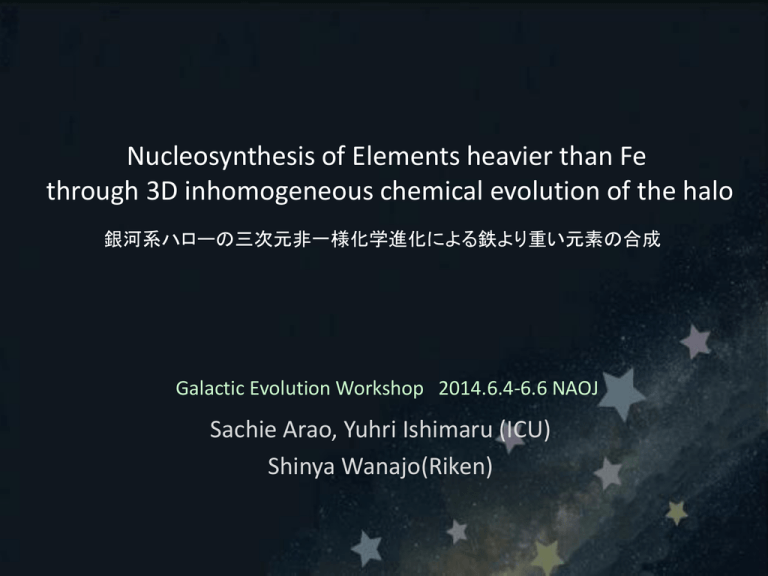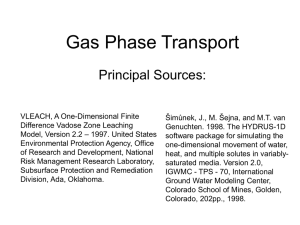Galactic Evolution Workshop*2014.6.4
advertisement

Nucleosynthesis of Elements heavier than Fe through 3D inhomogeneous chemical evolution of the halo 銀河系ハローの三次元非一様化学進化による鉄より重い元素の合成 Galactic Evolution Workshop 2014.6.4-6.6 NAOJ Sachie Arao, Yuhri Ishimaru (ICU) Shinya Wanajo(Riken) Ⅰ. Motivation -Problem posed by observational abundance- Observational traits of chemical abundance −clues for the Galactic Chemical Evolution (GCE)− α-elements Fe-peak elements n-capture elements? 2 1 different trends & small dispersion O 2 1 Mn Sr 0 [El/Fe] 1 0 -1 -1 -2 -2 1 -5 -3 1 -5 0 -1 -5 -4 -3 [Fe/H] -1 0 -4 -3 [Fe/H] -1 0 2 -4 -3 [Fe/H] -1 0 3 Zn Mg 2 large dispersion 1 2 0 1 -1 0 1 Eu [El/Fe] 1 0 -1 -5 -4 -3 [Fe/H] -1 0 -2 1 -5 -4 -3 [Fe/H] -1 0 1 -1 -5 -4 -3 [Fe/H] -1 0 What kind of GCE model can explain consistently these different trends in abundance? observational data : from SAGA database 1 Consistent GCE explanation for Zn and Sr ? n-capture elements? (Sr) 2 1 1 0 [Sr/Fe] [Zn/Fe] Fe-peak elements (Zn) 0 trend & small dispersion -1 -2 -5 -4 -3 [Fe/H] -1 homogeneous abundance? (homogeneous model) 0 -1 -2 1 -3 -5 large dispersion the early halo difficult to explain different trends of Fe-peak elements especially Zn -4 -3 [Fe/H] -1 0 1 spatial inhomogeneity of abundance ?? (inhomogeneous model) can explain small dispersion & trend of Zn as reproducing large dispersion of rprocess elements? examine inhomogeneous model supposed from r-process elements observational data: from SAGA database Ⅱ. Methods Modeling of 3D inhomogeneous GCE Modeling of GCE:Inhomogeneous Model O: outflow mS: stellar mass Xi: ratio of element I in gas τM: lifetime of star ★a system : (2.5kpc) 3 cube of the halo (1003 cells) ★reproduce spatial structure of chemical abundance ★Star formation: choose cell with calculated probability (∝mG) ★SNe: distribute yield to surrounding cells at calculated RSN. star formation :Ψ=νmG [M◉/Gyr] mG: gas density ν [Gyr-1]: star formation efficiency 2.5kpc 100cells outflow: output of gas from the system O=omG [M◉/Gyr] o [Gyr-1]:outflow efficiency radius of SNe shock wave front RSN: function of mG, metallisity, and Eexplosion RSN~100-300[pc] initial mass fanction(IMF):Φ(M)=AM-X X=1.35(Salpeter) ※parameters ν[Gyr-1], o[Gyr-1] parameter choice by metallisity distribution Modelー Observation (An et al. 2012)・・・ parameters which reproduce metallisity distribution of the halo: star formation efficiency ν=0.07[Gyr-1] outflow efficiency o=0.45[Gyr-1] Inhomogeneous evolution of the halo (cross section of the system) age of the Galaxy:20 Myr 100 Myr 500 Myr 2500 Myr gas density of cells [M◉/cell] gas is swept up by shock wave inhomogeneity of ISM occurs by different yields of each SNe, and become more homogeneous through the time Ⅲ. A Possible Solution for the issue explanation for Zn? -Electron Capture SN- Possible Solution for Znproblem: ECSN Electron Capture Supernova(ECSN): a part of 8-10M◉ (※lower limit of ECSN unknown) O-Ne-Mg core gravitationally collapse by electron capture long lifetime, low Eexplosion ~10^50erg (<10^51erg(SNII)) envelope(H,He) O-NeMg core ECSN yield solar fraction Zn Sr ECSN model (considering SNe hydrodynamics) (Wanajo et al. 2011, 2013) 8.8M◉ECSN produce Zn-Zr sufficiently yield: Zn…higher than Fe Fe…~10^-1 lower than SNII Co Fe Cr Mn Wanajo+ 2013 explain observational trend of Zn with ECSN yield?? → consider SNII+ECSN Supposition & Approximation in GCE model ECSN lower limit →9M◉ Eexplosion →EECSN=ESNII=10^51[erg] only ECSN is considered as origin for Sr Ⅳ. Results and Discussions Zn: SNII & SNII + ECSN, comparison with homogeneous Zn & Sr : SNII + ECSN Result① : Zn (noECSN&ECSN) SNeII ECSN: Mlow =9.0 SNeII + ECSN ○ number density of model star 2 2 ν=0.07 [Gyr-1] o=0.45 [Gyr-1] 1 [Zn/Fe] Zn [Zn/Fe] 1 0 -1 -2 + observation (SAGA database) 0 -1 -2 -6 -4 [Fe/H] -2 0 -6 -4 [Fe/H] -2 SNII+ECSN→ can explain large values at low [Fe/H] and the decreasing trend effect of low Fe yield and higher Zn yield than Fe of ECSN homogeneous model : shows increasing trend mean abundance → ECSN effect appears at high [Fe/H] (=later) ※[Fe/H]∝time 0 Result② : Zn & Sr Zn ECSN: Mlow =9.0 ν=0.07 [Gyr-1] 2 0 -2 0 -2 ○ number density of model star -3 o=0.45 [Gyr-1] 2 + observation (SAGA database) [Sr/Fe] [Zn/Fe] SNeII + ECSN Sr -6 -4 [Fe/H] -2 0 -3 -6 -4 [Fe/H] -2 0 consistently explain trend of Zn and large dispersion of Sr need to examine other origins of Sr & approximations Ⅴ. Summary make a 3D inhomogeneous GCE model As considering ECSN, Inhomogeneous model can explain trend of Zn better than homogeneous model explain consistently the trend of Zn and large dispersion of Sr in observation Future Plan: examine other origins of Sr (r-process), parameters & approximations Reference • Prantzos, N. 2008, “An Introduction to Galactic Chemical Evolution” • Argast, D., Samland, M., Thielemann, F.-K., & Gerhard, O.E. 2000, Astronomy & Astrophysics, Volume 356, pp.873-887 • Sneden, C., Cowan, J. J. 2003, Science, Volume 299, p.7 • Norris et al. 2001, THE ASTROPHYSICAL JOURNAL, 561:1034-1059 • Francois et al. 2004, A&A 421, 613–621 • Nomoto et al. 1997, nphysa, 616, 79 • Cioffi et al. 1988, THE ASTROPHYSICAL JOURNAL, 334: 252-265







